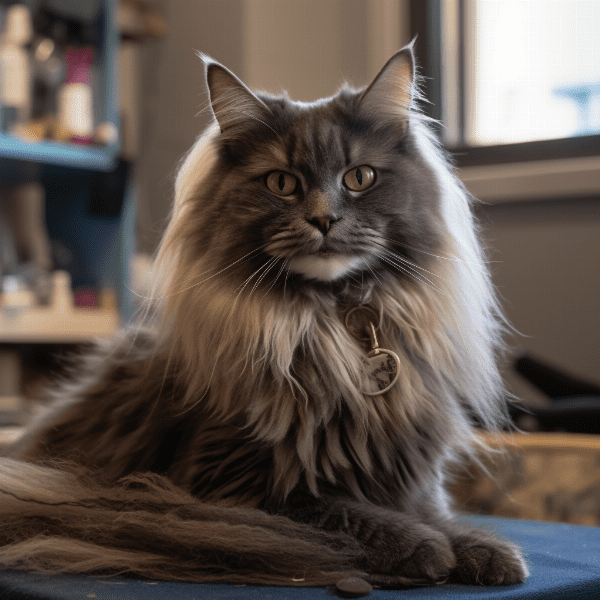Table of Contents
- Understanding the Importance of Regular Brushing for Long Haired Cats
- Choosing the Right Brush for Your Long Haired Cat’s Coat Type
- Preparing Your Long Haired Cat for a Brushing Session
- Step-by-Step Guide to Brushing Your Long Haired Cat’s Coat
- Dealing with Tangles and Mats in Your Long Haired Cat’s Fur
- Tips for Keeping Your Long Haired Cat Calm and Comfortable During Brushing
- Addressing Common Grooming Issues in Long Haired Cats
- How Often Should You Brush Your Long Haired Cat’s Coat?
- Additional Grooming Considerations for Long Haired Cats
- Conclusion: Maintaining Your Long Haired Cat’s Health and Beauty through Brushing
Understanding the Importance of Regular Brushing for Long Haired Cats
Long haired cats are undeniably beautiful, but their fur can be a nightmare to manage if not cared for properly. Regular brushing is a crucial part of maintaining the health and appearance of your long haired feline friend. In this section, we’ll explore the reasons why brushing is so important for long haired cats.
Promotes Healthy Skin and Coat
Brushing your long haired cat’s coat helps to distribute the natural oils throughout their fur, which helps to keep their skin moisturized and healthy. This is particularly important for cats that are prone to dry skin or skin allergies. A healthy coat is also more resistant to mats and tangles, which can be painful and difficult to remove if left unchecked.
Reduces the Risk of Hairballs
Long haired cats are more prone to hairballs than their short haired counterparts. When cats groom themselves, they inevitably ingest some of their own fur. If the fur is not removed through brushing, it can accumulate in the digestive tract and cause blockages. Regular brushing can help to remove loose fur before it is ingested, reducing the risk of hairballs.
Helps to Identify Skin and Health Issues
Regular brushing sessions give you an opportunity to check your long haired cat’s skin for any abnormalities, such as lumps, bumps, or sores. This can be particularly important for older cats, as they are more susceptible to health issues. Brushing also allows you to check for fleas and ticks, which can carry diseases and cause discomfort for your cat.
Strengthens the Bond between You and Your Cat
Brushing your long haired cat is not only good for their physical health, but it can also strengthen the bond between you and your furry companion. Regular grooming sessions can be a relaxing and enjoyable experience for both you and your cat, and can help to build trust and affection.
In conclusion, regular brushing is an essential part of maintaining the health and well-being of your long haired cat. It promotes healthy skin and coat, reduces the risk of hairballs, helps to identify health issues, and strengthens the bond between you and your cat.
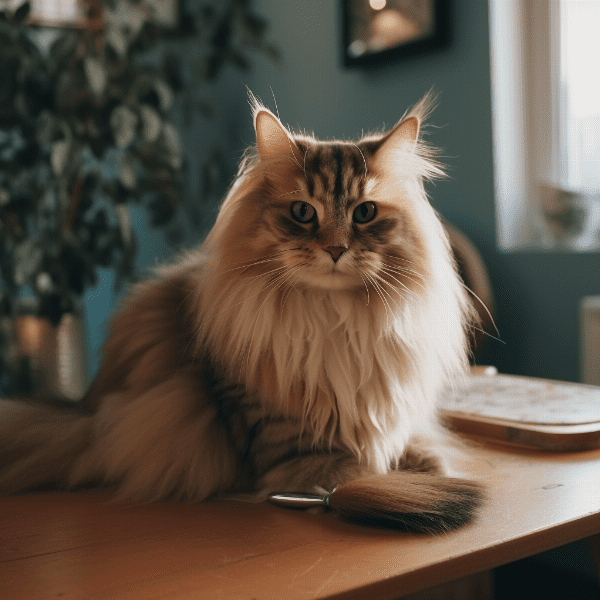
Choosing the Right Brush for Your Long Haired Cat’s Coat Type
Selecting the right brush for your long haired cat’s coat type is critical for effective grooming. Different brushes are designed to work with different coat types, so it’s essential to choose one that will be effective in removing loose hair and preventing mats and tangles.
Determine Your Cat’s Coat Type
Before selecting a brush, you should first determine your cat’s coat type. Long haired cats can have a variety of coat types, including silky, woolly, and wiry. Each coat type requires a specific type of brush to be most effective.
Slicker Brushes
Slicker brushes are a common choice for long haired cats with silky or fine fur. These brushes have fine, short wires that are close together, making them effective at removing loose hair and preventing mats and tangles. Slicker brushes are gentle and suitable for everyday use, but they should be used with care to avoid damaging the skin.
Undercoat Rakes
Undercoat rakes are a good choice for long haired cats with thick, woolly coats. These brushes have long, widely spaced teeth that can reach down into the undercoat to remove loose hair and prevent mats and tangles. Undercoat rakes are more aggressive than slicker brushes, so they should be used with caution and only on cats with thick coats.
Combs
Combs are a versatile grooming tool that can be used on any long haired cat, regardless of coat type. They come in different sizes and styles, and some have teeth that are widely spaced, while others have teeth that are close together. Combs are effective at removing loose hair, but they may not be as effective at preventing mats and tangles as other types of brushes.
Shedding Tools
Shedding tools, such as furminators or deshedding gloves, are designed to remove loose hair from your cat’s coat quickly and efficiently. These tools are particularly useful during shedding season when your cat is shedding a lot of hair. Shedding tools are not suitable for everyday use, as they can damage the skin if used too often.
In conclusion, choosing the right brush for your long haired cat’s coat type is essential for effective grooming. Slicker brushes are ideal for cats with silky fur, undercoat rakes are best for cats with thick, woolly coats, combs are versatile and suitable for all coat types, and shedding tools are useful for removing loose hair during shedding season. By selecting the right brush for your cat’s coat type, you can keep their fur healthy and prevent mats and tangles from forming.
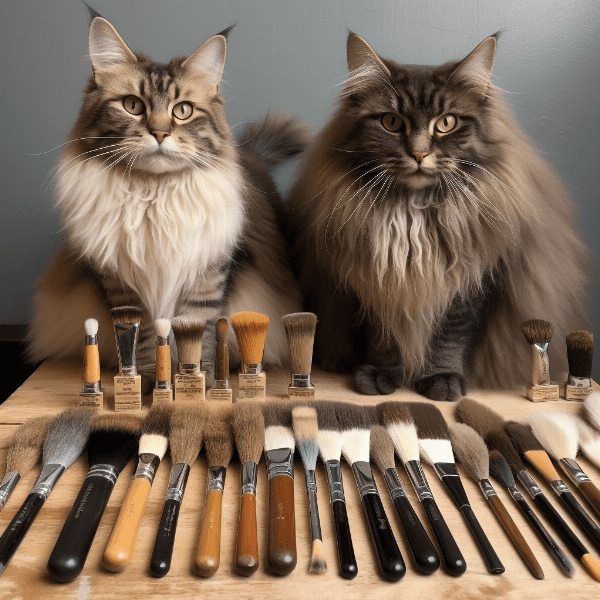
Preparing Your Long Haired Cat for a Brushing Session
Before beginning a brushing session with your long haired cat, it’s essential to prepare both your cat and your grooming area to ensure a successful and stress-free experience. In this section, we’ll explore the steps you can take to prepare your cat for a brushing session.
Create a Calm Environment
Creating a calm and quiet environment is essential for preparing your cat for a brushing session. Choose a quiet room away from distractions and loud noises, and ensure that your cat is relaxed and comfortable before beginning the grooming process. Consider using calming aids, such as pheromone sprays or calming music, to help your cat relax.
Gather Your Grooming Supplies
Before beginning the grooming session, gather all of the supplies you’ll need. This may include a brush, comb, shedding tool, and scissors for trimming any mats or tangles. Having everything you need within reach will prevent interruptions and keep your cat calm and focused.
Introduce Your Cat to the Brush
Introduce your cat to the brush before beginning the grooming session. This will help your cat become familiar with the brush and reduce any anxiety or fear they may have. Offer your cat a treat or a toy as a distraction, and gently introduce the brush to your cat’s fur. Use a light touch at first, and gradually increase the pressure as your cat becomes more comfortable.
Gently Remove Any Mats or Tangles
Before beginning the grooming session, gently remove any mats or tangles in your cat’s fur using scissors or a comb. Mats and tangles can be painful for your cat, so it’s essential to remove them before beginning the brushing process.
Start Slowly
Begin the grooming session slowly and gradually increase the duration of the brushing sessions as your cat becomes more comfortable. Use gentle strokes, and avoid pulling or tugging on your cat’s fur. If your cat becomes agitated or uncomfortable, take a break and try again later.
In conclusion, preparing your long haired cat for a brushing session is essential for a successful and stress-free grooming experience. Creating a calm environment, gathering your grooming supplies, introducing your cat to the brush, gently removing any mats or tangles, and starting slowly can all help to ensure a positive experience for both you and your cat.

Step-by-Step Guide to Brushing Your Long Haired Cat’s Coat
Brushing your long haired cat’s coat can be a daunting task, but with the right technique and tools, it can be an enjoyable and rewarding experience for both you and your cat. In this section, we’ll provide a step-by-step guide to brushing your long haired cat’s coat effectively.
Step 1: Begin with a Slicker Brush
Begin by using a slicker brush to remove any loose hair and prevent mats and tangles from forming. Use gentle, sweeping motions to brush your cat’s fur, starting at the head and working your way down to the tail. Be sure to brush in the direction of the hair growth, and avoid brushing too vigorously, as this can cause discomfort for your cat.
Step 2: Use an Undercoat Rake
If your cat has a thick, woolly coat, use an undercoat rake to remove any loose hair from the undercoat. These tools are designed to penetrate the undercoat without damaging the topcoat, making them an effective tool for removing mats and tangles.
Step 3: Check for Mats and Tangles
Check your cat’s fur for any mats or tangles. If you find any, gently separate them using your fingers or a comb. Avoid pulling or cutting the mats, as this can cause discomfort or pain for your cat.
Step 4: Use a Comb to Finish
Finish by using a comb to remove any remaining loose hair and to smooth out your cat’s fur. Use a comb with widely spaced teeth for long haired cats to prevent discomfort or damage to the skin.
Step 5: Reward Your Cat
After completing the grooming session, reward your cat with a treat or a toy. This positive reinforcement can help to build trust and make the grooming experience more enjoyable for your cat.
In conclusion, brushing your long haired cat’s coat doesn’t have to be a difficult or stressful experience. By following these simple steps and using the right tools, you can effectively groom your cat’s coat, prevent mats and tangles, and strengthen your bond with your furry companion.

Dealing with Tangles and Mats in Your Long Haired Cat’s Fur
Tangles and mats can be a common problem for long haired cats, and they can be painful and uncomfortable for your furry friend. It’s important to address tangles and mats as soon as you notice them to prevent them from getting worse. In this section, we’ll explore the best techniques for dealing with tangles and mats in your long haired cat’s fur.
Step 1: Identify the Tangles and Mats
The first step in dealing with tangles and mats is to identify where they are located. Look for areas where the fur is clumped together or appears matted. Tangles can be gently worked out with your fingers or a comb, while mats may require more advanced techniques.
Step 2: Use a Detangling Spray
A detangling spray can be useful in loosening up tangles and mats in your cat’s fur. Apply the spray to the affected area and gently work through the tangle or mat with your fingers or a comb. Be careful not to pull or tug on the fur, as this can be painful for your cat.
Step 3: Trim Away Severe Mats
Severe mats may need to be trimmed away using scissors or clippers. Be very careful when trimming around sensitive areas, such as the ears or tail, to avoid accidentally cutting your cat’s skin.
Step 4: Use a Dematting Tool
A dematting tool can be useful in removing stubborn mats in your cat’s fur. These tools have sharp blades that can be used to gently cut through the mat without damaging the surrounding fur.
Step 5: Prevent Future Tangles and Mats
Preventing tangles and mats is the best way to avoid dealing with them in the first place. Regular brushing and grooming can help to prevent mats from forming, as can a healthy diet and exercise routine.
In conclusion, dealing with tangles and mats in your long haired cat’s fur can be a challenging task, but with the right techniques and tools, you can effectively remove them and prevent them from coming back. Be patient and gentle with your cat during the process, and remember to reward them with a treat or a toy when you’re finished.
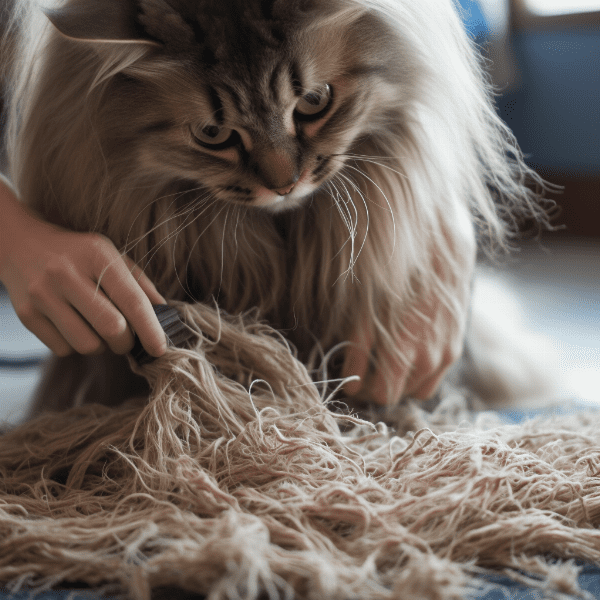
Tips for Keeping Your Long Haired Cat Calm and Comfortable During Brushing
Grooming your long haired cat can be a stressful experience for both you and your furry friend. Cats are sensitive animals, and they can become anxious or agitated during brushing sessions. In this section, we’ll explore some tips for keeping your long haired cat calm and comfortable during brushing.
Tip 1: Start Grooming Early
It’s important to start grooming your cat at a young age to get them used to the process. Regular grooming from a young age can help your cat become accustomed to being handled and brushed, reducing their anxiety and fear during grooming sessions.
Tip 2: Use Treats as a Reward
Using treats as a reward can be an effective way to keep your cat calm and comfortable during grooming sessions. Offer your cat a treat before and after the grooming session to help them associate the experience with positive feelings.
Tip 3: Use a Calming Aid
Calming aids, such as pheromone sprays or calming music, can be useful in reducing your cat’s anxiety during grooming sessions. These aids can help to create a relaxed and calming environment for your cat.
Tip 4: Take Breaks
If your cat becomes agitated or uncomfortable during the grooming session, take a break and try again later. Pushing your cat to continue when they are stressed or anxious can make the situation worse.
Tip 5: Be Gentle and Patient
Be gentle and patient with your cat during the grooming session. Use slow, gentle strokes, and avoid pulling or tugging on their fur. If your cat becomes uncomfortable or anxious, take a break and try again later.
Tip 6: Make Grooming a Positive Experience
Make grooming a positive experience for your cat by giving them plenty of praise and affection during the process. Speak to them in a calm and soothing voice, and reward them with treats and toys to reinforce good behavior.
In conclusion, keeping your long haired cat calm and comfortable during grooming sessions is essential for a successful and stress-free experience. Starting grooming early, using treats as a reward, using calming aids, taking breaks, being gentle and patient, and making grooming a positive experience can all help to reduce your cat’s anxiety and make grooming sessions more enjoyable for both you and your furry friend.
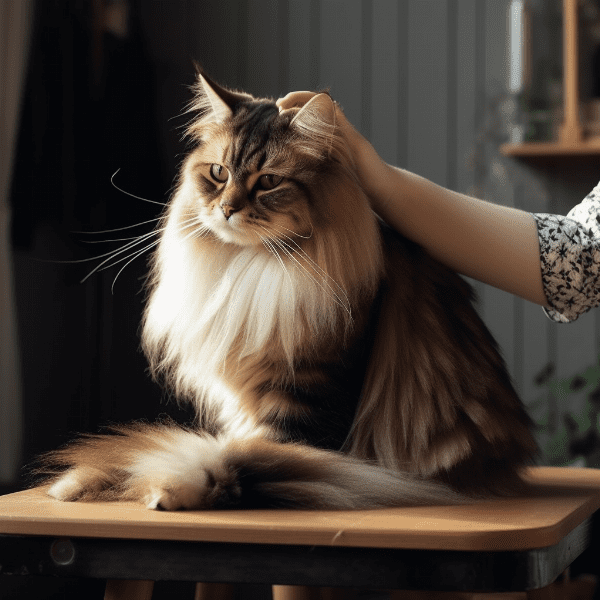
Addressing Common Grooming Issues in Long Haired Cats
Long haired cats require regular grooming to keep their coats healthy and free of mats and tangles. However, even with proper grooming, some common issues can arise. In this section, we’ll explore some of the most common grooming issues in long haired cats and how to address them.
Issue 1: Mats and Tangles
Mats and tangles can be a common problem in long haired cats, particularly if grooming sessions are not done regularly. To address this issue, use a slicker brush or comb to gently remove any mats or tangles. If the mats are severe, they may need to be trimmed away using scissors or clippers.
Issue 2: Shedding
Long haired cats can shed a lot, particularly during shedding season. To address this issue, use a shedding tool, such as a furminator or deshedding glove, to remove loose hair from your cat’s coat. You can also give your cat a regular bath to help remove excess hair.
Issue 3: Hairballs
Hairballs can be a common issue in long haired cats, particularly if they groom themselves excessively. To address this issue, give your cat a hairball remedy or a high-fiber diet to help prevent hairballs from forming. Regular brushing and grooming can also help to reduce the amount of hair your cat ingests.
Issue 4: Skin Irritation
Long haired cats are prone to skin irritation, particularly if they have mats or tangles in their fur. To address this issue, use a dematting tool or comb to remove any mats or tangles gently. You can also give your cat a regular bath using a mild shampoo designed for cats.
Issue 5: Overgrown Nails
Overgrown nails can be a common issue in long haired cats, as their long fur can make it difficult to see the nails. To address this issue, regularly trim your cat’s nails using a pair of cat nail clippers. Be careful not to cut the quick, as this can be painful for your cat.
In conclusion, grooming issues can arise in long haired cats, but with the right tools and techniques, they can be easily addressed. Regular grooming sessions can help to prevent issues from arising, but if you notice any problems, such as mats or tangles, shedding, hairballs, skin irritation, or overgrown nails, take action quickly to prevent further problems from developing.

How Often Should You Brush Your Long Haired Cat’s Coat?
Regular brushing is essential for maintaining your long haired cat’s coat and preventing mats and tangles. However, the frequency of brushing can vary depending on your cat’s coat type and lifestyle. In this section, we’ll explore how often you should brush your long haired cat’s coat.
Coat Type
The type of coat your cat has can determine how often they need to be brushed. Cats with longer, thicker fur may need to be brushed more frequently to prevent mats and tangles. Conversely, cats with shorter, finer fur may not need to be brushed as often.
Lifestyle
Your cat’s lifestyle can also determine how often they need to be brushed. Indoor cats may not need to be brushed as often as outdoor cats, as they are not exposed to the same environmental factors that can cause mats and tangles.
Frequency
As a general rule, long haired cats should be brushed at least once a week to prevent mats and tangles from forming. However, if your cat has a thicker or longer coat, they may need to be brushed more frequently, such as every other day.
During shedding season, which can occur twice a year, your cat may need to be brushed more frequently to remove loose hair and prevent hairballs.
Signs That Your Cat Needs Brushing
It’s important to pay attention to your cat’s coat and behavior to determine when they need to be brushed. Signs that your cat needs brushing include mats or tangles in their fur, excessive shedding, and grooming themselves excessively, which can lead to hairballs.
In conclusion, how often you should brush your long haired cat’s coat depends on their coat type and lifestyle. As a general rule, cats should be brushed at least once a week to prevent mats and tangles from forming. Pay attention to your cat’s coat and behavior to determine when they need brushing, and adjust the frequency of brushing as needed.

Additional Grooming Considerations for Long Haired Cats
Long haired cats require regular grooming to maintain their coat’s health and appearance. In addition to the techniques and tools we’ve discussed so far, there are some additional grooming considerations to keep in mind. In this section, we’ll explore some of these considerations.
Regular Baths
Long haired cats can benefit from regular baths to keep their coats clean and free of mats and tangles. Use a mild shampoo designed for cats and avoid getting water in their ears or eyes. Rinse your cat thoroughly and dry them off with a towel or hair dryer on a low setting.
Professional Grooming
If you find it difficult to groom your long haired cat, consider taking them to a professional groomer. Professional groomers have experience with long haired cats and can help to remove mats and tangles safely and effectively.
Diet
Your cat’s diet can also play a role in their coat’s health and appearance. A high-quality diet rich in protein and omega-3 fatty acids can help to promote a healthy coat and reduce shedding. Consult with your veterinarian to determine the best diet for your cat’s needs.
Flea Prevention
Long haired cats are particularly susceptible to fleas and ticks, which can cause skin irritation and lead to mats and tangles. Use a flea prevention treatment recommended by your veterinarian to keep your cat free of these pesky parasites.
Dental Care
Dental care is an essential part of your cat’s overall health and wellbeing, including their coat’s health. Brush your cat’s teeth regularly or use dental treats or toys to help keep their teeth clean and healthy.
In conclusion, long haired cats require regular grooming to keep their coats healthy and free of mats and tangles. In addition to regular brushing, consider regular baths, professional grooming, a healthy diet, flea prevention, and dental care to keep your cat looking and feeling their best.

Conclusion: Maintaining Your Long Haired Cat’s Health and Beauty through Brushing
Grooming your long haired cat can be a rewarding experience for both you and your furry friend. Regular brushing can help to maintain your cat’s coat’s health and appearance, prevent mats and tangles, and reduce shedding. In this guide, we’ve explored effective Long haired cat brushing techniques, how to choose the right brush for your cat’s coat type, and how to deal with tangles and mats in their fur. We’ve also discussed tips for keeping your cat calm and comfortable during grooming sessions, addressing common grooming issues, and additional grooming considerations.
By following these techniques and tips, you can help maintain your long haired cat’s health and beauty through brushing. Remember to start grooming your cat early, use treats as a reward, and be gentle and patient during grooming sessions. Use the right tools and techniques to address common grooming issues, such as mats, shedding, hairballs, skin irritation, and overgrown nails. And consider additional grooming considerations, such as regular baths, professional grooming, a healthy diet, flea prevention, and dental care.
With regular grooming, your long haired cat can look and feel their best, and you can enjoy a happy and healthy relationship with your furry friend.
